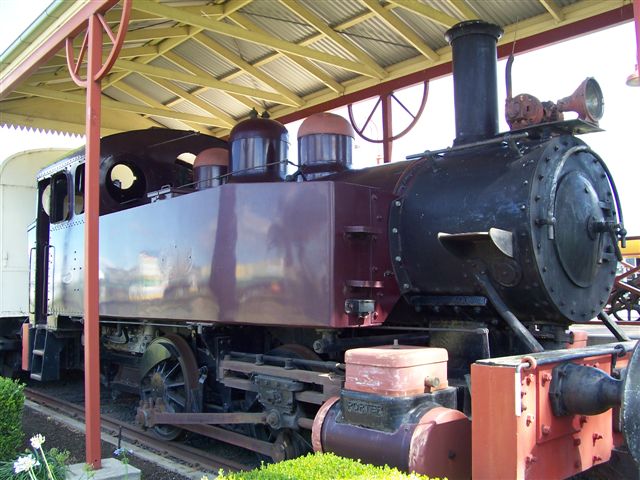|
|
BHP Newcastle No.16 Plinthed at St Marys |
|

BHP photo of BHP No. 16 is kindly provided by David
Tickner. 3 December 2005
Missing brass number plates, window frames etc, hopefully
in safe keeping rather than stolen.
|
Builder |
H.K.
Porter Co, Pittsburgh USA |
|
Builder’s Number & Year |
6596 of 1920 |
|
Wheel Arrangement |
0-4-0T |
|
No. in class |
18 |
|
The H. K.
Porter Company of Pittsburgh specialised in small 4-wheel steam locomotives
for industrial and construction use, although some larger main-line
locomotives were also built. H. K. Porter also became a dominant manufacturer
of small compressed-air locomotives for underground operation, and fireless
locomotives for use in chemical plants and refineries where the risk of fire
prohibited the conventional steam locomotives. Among
their many customers worldwide was the BHP Newcastle steelworks, established
in 1915, which settled on the Porter 0-4-0T design as their de-facto standard
for shunting work. Porter initially supplied three 0-4-0T locomotives to BHP
Newcastle (Nos.2 - 4), later joined by a further 7 Porter examples and 8
copies built in BHP Newcastle’s own workshops. Porter also supplied smaller
915mm gauge 0-4-0ST locos to the BHP Newcastle plant for the internal ingot
transfer line. These locos rubbed shoulders with an eclectic mix of steam
locomotives at the Newcastle steelworks, including ‘funnies’ converted for
shunting work - such as 0-6-0ST No.1, rebuilt from NSWGR E17 class 0-6-0 E40
(Henry Vale b/n 5 of 1870) and No.26, rebuilt from NSWGR 2-6-0 tender loco
No.2415. (Leon Oberg provides a thorough account of the interesting steam
fleet at BHP Newcastle in the fifth edition of his ‘Locomotives of Australia
– 1854 to 2010, together with anecdotes and insights from former BHP
employees.) Upon
dieselisation of the BHP Newcastle shunting fleet, most of their steam
locomotives quickly found themselves as feed for the company steelmaking
furnace, but a lucky few were transferred or sold for further duties
elsewhere. With the
arrival of standard gauge link to the BHP Whyalla steelworks in South
Australia, two of the BHP built 0-4-0T copies were relocated there – becoming
B1 (formerly No.21) & B2 (formerly No.25) on the local roster. B2 lasted
the longest at Whyalla but alas was scrapped in 1968. It would have made a
fine specimen for local preservation, or an interesting addition to at the
Mile End Railway Museum, adding to the story of South Australia’s economic
development and gauge quandaries. Porter No.4 (one of the original batch of
three Porter 0-4-0T locomotives) was sold to Commonwealth Steel Co Ltd,
Newcastle in 1962 and is now preserved in the Dorrigo Steam Railway &
Museum collection. Porter
engine No.16 was sold to Emu Gravel in western Sydney in 1962, followed by No.12
in 1963, joining an older Vulcan built 0-4-0ST loco No.1 at the gravel pits. No.12
lasted in service until 1967 when road transport took over at the gravel pits.
While BHP No.16 and No.1 were subsequently preserved, alas BHP No.12 was not
so lucky, despite being the last loco in steam there, and was cut up for
scrap in 1968. John Oakes provides a good account of the railway operations
at Emu Plains in his book ‘Sydney’s Forgotten Quarry Railways’ as referenced
below. No.16 was
saved by the NSW Rail Transport Museum (now NSW Rail Museum)
when purchased for preservation in August 1967, at that time in operating condition.
It initially served as shunter at the Enfield museum site, hauling much larger
locomotives in and out of the radial roundhouse roads. It remained in the museum
shunter role upon transfer to the new site at Thirlmere in 1975, still seeing
occasional use until the mid-1990's. In more
recent times BHP Newcastle No.16 has been placed on loan to an organisation
at St Marys in western Sydney, where it is now plinthed under a substantial weather
roof. It is located on the corner of Mamre Rd & Hall St, and appears to
be well cared for, as per the photos appearing on this page. (I recall being
rather disappointed at this loco’s move to a static display, which seemed a
rather retrograde step. In fairness, the loco has been provided with a decent
presentation and shelter, and it does have an association with the area given
its service at Emu Gravel, not far from St Marys.) Perhaps
someone could contribute a photo of BHP Newcastle No.16 shunting at Thirlmere
or Enfield, for addition to this page? |

BHP Newcastle No.16 as seen from across the street (from
the south) on 16 August 2015.
The locomotive is protected by an
elaborate & ornate weather shelter!
I understand the more modern air-conditioned carriage
behind serves as a training facility.

BHP Newcastle No.16 as seen from the North side. 16 August
2015

Rear side view. It can be seen where the ‘BHP 16’ number
plates were affixed to the cabside and side tank.

Cylinder detail, showing the maker’s name included in the
cylinder casting.
The piston rod and slide bars are certainly getting rusty!

The oversize buffers tell of shunting on tightly curved
sidings - and the need to avoid buffer lock.
References
|
a |
‘Locomotives of Australia’ by Leon Oberg, published by J. W. Books Pty Ltd |
|
b |
Oakes, J. ‘Sydney’s Forgotten
Quarry Railways’, Second edition 2013, published by
the Australian Railway Historical
Society, NSW Division, ISBN 978-0-9757870-3-8 |
|
|
Page updated: 12 December 2021
|
Government Railways: |
|
|||||||||
|
Private & Industrial Railways: |
|